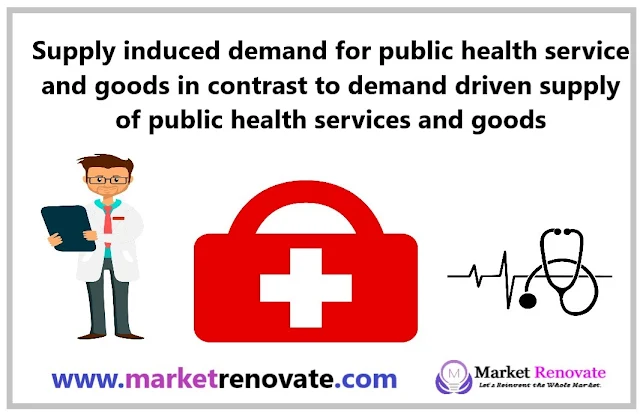Supply induced demand for public health service and goods in contrast to demand driven supply of public health services and goods
Supply and demand dynamics in the market for public health services and goods have a complex impact on accessibility, availability, and utilization of essential healthcare resources. Two distinct approaches stand out: demand-driven supply and supply-induced demand. These approaches embody diverse strategies and philosophies that affect the provision of public health services, and each has its own effects on healthcare systems and the well-being of communities.
Supply-Induced Demand for public health service and goods
Supply-induced demand refers to a phenomenon in which the availability of healthcare services or products increases their utilization. Simply put, the increase in supply encourages more individuals to seek out and utilize these services. This phenomenon frequently occurs as a result of factors such as increased marketing efforts, the establishment of new healthcare facilities, or the introduction of innovative medical technologies. The rationale behind supply-induced demand is that when services are more accessible and convenient, individuals are more likely to choose treatments or interventions that they would have otherwise declined.
Consider a community in which a new, cutting-edge medical center is established. This facility’s introduction, which includes sophisticated diagnostic equipment and specialized medical personnel, may attract the interest of locals. People who previously refrained from seeking medical attention due to inconvenience or lack of nearby resources may now be enticed to undergo health check-ups, screenings, and treatments. This is a prime example of how a greater availability of healthcare services can stimulate demand.
While supply-induced demand can increase healthcare utilization and prompt intervention, it also poses challenges. The increased demand caused by an increased supply may strain healthcare resources, resulting in longer appointment wait times, higher healthcare costs, and a diversion of resources to areas with greater requirements. In addition, the emphasis on generating demand could divert attention away from addressing underlying health determinants or preventive measures, thereby influencing the long-term health outcomes of the population.
Demand-Driven Supply of public health services and goods
On the opposite end of the spectrum is demand-driven supply, in which healthcare services and products are tailored to meet the population’s actual needs and preferences. In this strategy, community demand controls the distribution of healthcare resources. It emphasizes understanding the health requirements, cultural contexts, and priorities of the target population prior to expanding services or allocating resources.
Consider a region where chronic diseases are prevalent. Demand-driven supply would involve investing in prevention programs, health education campaigns, and access to affordable medications instead of opening numerous specialty clinics. By matching services to the population’s actual health needs, demand-driven supply seeks to improve health outcomes while preventing overutilization.
Balancing Act: Finding the Middle Ground
The contrast between supply-induced demand and demand-driven supply poses a delicate balancing act for healthcare systems. To maximize healthcare accessibility and quality without straining resources or jeopardizing preventive efforts, it is essential to strike the proper balance.
One strategy incorporates aspects of both approaches. Where there is evidence of unmet demand, healthcare providers can increase supply while simultaneously investing in preventative measures, health promotion, and community engagement to shape demand in accordance with long-term health objectives.
Community Engagement and Informed Decision-Making
Involving the community in decisions regarding healthcare services and products is fundamental to the demand-driven supply strategy. By involving community members, gaining a comprehension of their health priorities, and soliciting their input, healthcare providers can make decisions that reflect the actual needs of the population.
Data-Informed Strategies
Data is essential for guiding supply decisions. The collection and analysis of robust data enables healthcare systems to identify patterns of health requirements and utilization, directing resource allocation to the most effective areas.
Conclusion
In the complex landscape of public health services and products, the interaction between supply-induced demand and demand-driven supply highlights the need for a holistic strategy. The key to attaining equitable healthcare access and sustainable health outcomes is striking a balance between expanding services to meet actual demand and ensuring responsible resource allocation. By incorporating the benefits of both approaches, healthcare systems can navigate the ever-changing obstacles associated with providing accessible, high-quality, and community-based care.






Please leave your comments or ask your queries here. The comments shall be published only after the Admin approval.